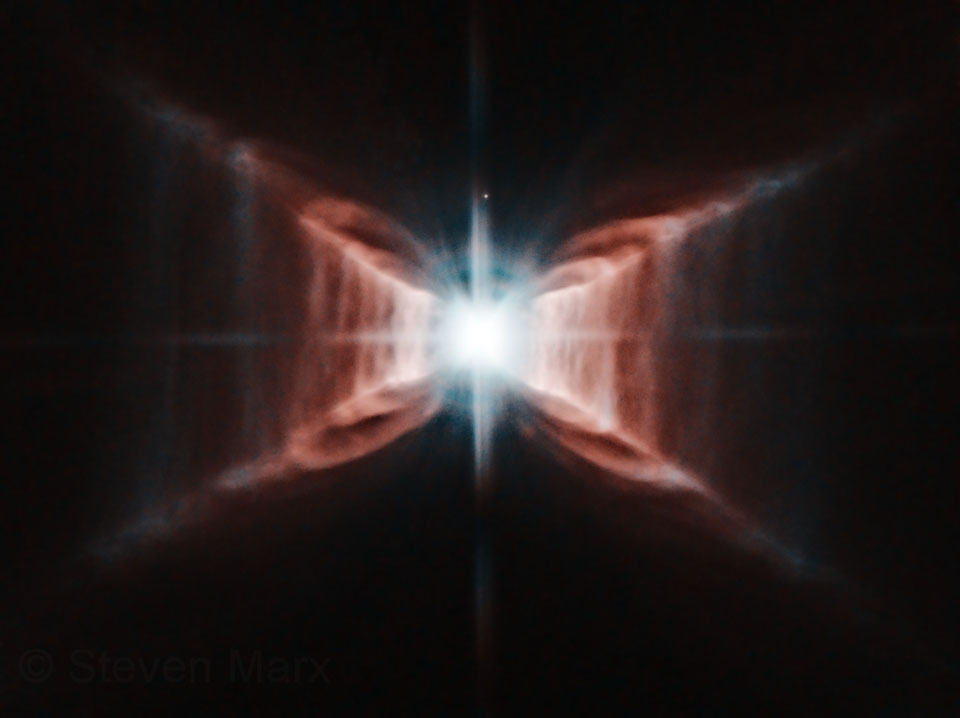Object 107: Red Rectangle
The Red Rectangle is a bright star with a strange nebula around it. It has long been known to be a binary; there are two stars about 0.2 arcseconds apart and of equal brightness, although some observers failed to see the second star.
In the early 1970's, people found a strong infrared excess. Infrared emission comes from dust, and the excess indicated of a dusty envelope. When people looked at old photographic plates (the Palomar Sky Survey), red plates showed a peculiar rectangular structure. Martin Cohen gave it the name "Red Rectangle" [1]. It was already clear to be much more complicated than that. There were bright spikes coming out from the corners of the rectangle. It was more an "X" than a rectangle.
The infrared emission itself was also quickly found to be unusual. It shows features which had been seen in a few other objects (such the planetary nebula NGC 7027) but which had uncertain identification. We now know that these are due to complex molecules: polycyclic aromatic hydrocarbons.
Better observations found that the stars looked fuzzy. It was impossible to explain them as a normal binary system; it would require absurd masses [1].
The next discovery involved the star. Spectra showed that the iron lines that would normally be seen were much too weak. When calculating how much iron there was, more than 99% was missing. Other elements also were lacking. but not all. There was a pattern; elements that can form solid particles (such as iron) were missing, but elements that don't (such as oxygen and zinc) had their usual abundance. It was clear this was not the original composition of the star. It had been changed [2].
By this time the star was already thought to be in the final state of evolution before becoming a white dwarf. A star like the Sun ejects much of its mass at the end of its life. The remnant star briefly becomes very bright and hot before running out of fuel and ending its life as a white dwarf. The rectangular nebula could be this material ejected by the star.
Things became more complex. High resolution imaging showed that, instead of two stars, there were none. That is not quite true. The images showed that the central star was invisible when looked at directly but could be seen as reflections from the surrounding nebula. Because the nebula has two lobes, there were two reflections; the same star was seen twice. This explained the apparent binarity. But the star itself was obscured by something - a disk of dust particles [3]. This was where the missing elements had gone.
Observations continued. Spectra showed that the velocity of the star was changing periodically. The same variation was seen in the brightness. This looked like an orbit [2, 4]. The period was found to be around 300 days. Now the invisible star was a binary again, with an orbit similar in size to that of the Earth. Only the bright star was seen in reflected light; the other star was much fainter. The disk of dust was located just outside of the orbit of the two.
But the weirdness continued. The rectangle/X-shaped nebula contained carbonaceous molecules. These form when the gas is carbon rich, i.e. there is more carbon than oxygen. The star, however, had about the same amount of carbon and oxygen - clearly different from the nebula. And the dust disk was different again, because it showed silicate dust and this is seen where there is more oxygen than carbon. How was this possible? The current thinking is that the disk is older and formed first and that the star became carbon rich later, after which the extended nebula formed. More recently, gas from the dust disk, without the elements that formed the dust, fell back unto the star and caused the strange iron depletion [5].

The Red Rectangle as seen by the Hubble Space Telescope. Image Credit: ESA, Hubble, NASA; Reprocessing: Steven Marx, Hubble Legacy Archive.
The Hubble Space Telescope complicated things further [6]. It showed the prominent "X" shape, but now the sides of the "X" were connected by almost straight lines, giving the impression of the rungs of a triangular ladder. The structure is seen only in the red. The blue image only showed the reflection nebula near the center. The rungs end in bright spots along the "X", outside of which the material seems to curve back to the star [7].
The cause of the "ladder rungs" is much discussed. Nico Koning et al. explain it as a projection effects, where the bipolar flow cuts through a series of concentric spherical shells [8]. It gives a fair but not perfect fit. The model actually fits other objects very well, such as Hubble 12. Pablo Velazquez et al. instead use a precessing jet to explain the rungs [9]. That can explain some aspects, but it does not explain the backflow.
Is the Red Rectangle unique? We have found a number of evolved stars that share the mixed chemistry with an oxygen-rich disk and a younger carbon-rich outflow. All are binaries. We have also found that share the depletion of dust-forming elements. They too tend to be binaries. A number of stars are known that show structures reminiscent of the "rungs" of the Red Rectangle. They too are binaries. In a way, the Red Rectangle brings these groups together.
In astronomy, one star shows a new phenomenon, a prototype. Two stars create a class and three stars form a class with an exception. And often, the prototype turns out to be that exception. So we now a number of stars that share characteristics with the Red Rectangle, and all show how important binary interaction in the final stages of the evolution of a star. But the Red Rectangle remains exceptional.